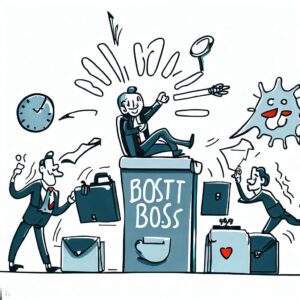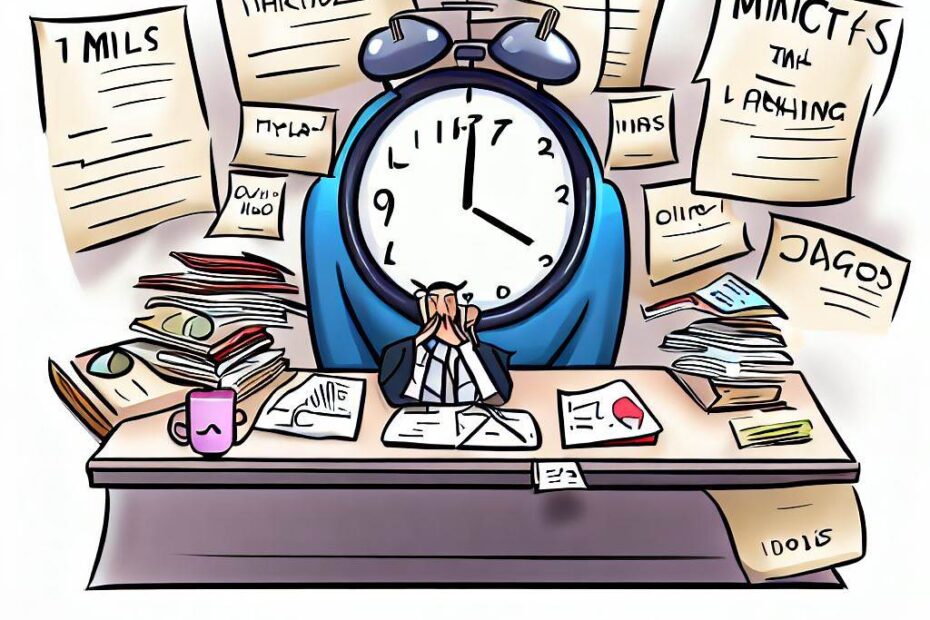Time management 101 is a fundamental skill that involves prioritizing tasks, organizing them efficiently, and minimizing distractions. When it comes to managing time effectively, setting priorities is essential. If someone claims that they didn’t have time to complete a project, it’s likely because they didn’t assign enough priority to it. By understanding the importance of prioritization, individuals can avoid wasting time on tasks that are not as crucial.
One way to stay organized and manage time effectively is by using a paper planner. A planner that includes a Filefax, weekly and yearly view can help individuals determine their position in the year and track progress over time. It’s important to mark every task on the planner, no matter how simple or obvious it may seem. Time has a way of fading away, and individuals must make sure to use it wisely.
Using a calendar with a week-at-a-glance view is also helpful in managing time. It allows individuals to see their weekly schedule and plan accordingly. Additionally, it’s recommended to attack unpleasant tasks early in the day. This includes calling someone you don’t get along with, for example. By completing unpleasant tasks early, individuals can avoid procrastination and focus on more enjoyable tasks later in the day.
Distractions can be a major hindrance to time management. It’s important to minimize distractions while working by closing the door, ignoring the phone, fax machine, and not checking emails. Individuals must focus on the task at hand and avoid any distractions that may cause them to lose focus. It’s recommended to set a specific time chunk, such as half an hour, one hour, or two hours, and stay focused during that time.
Creating a routine that gets you in the groove can help establish a productive mindset. For example, having a routine of working out, having coffee, and starting the day can set the tone for a productive day ahead. Alain, for instance, only uses his palm pilot to save contact lists, not for planning. He also uses chunks of two hours because he feels that he gets diminishing returns after that time.
Rewarding oneself after each two-hour chunk can keep motivation high. Individuals can reward themselves by getting a coffee, going outside for a walk, or playing a computer game. By breaking up the day into manageable chunks and rewarding oneself for staying focused during those chunks, individuals can maintain a productive mindset and manage time effectively.
Finally, improving by one percent each day can lead to significant improvement in skills in just a month. According to Tagushi, by focusing on continuous improvement, individuals can achieve significant gains in a short amount of time. It’s essential to remain committed to the process and stay focused on the end goal.
So managing time effectively requires setting priorities, staying organized, minimizing distractions, and creating a routine. By understanding the importance of time management and implementing these strategies, individuals can make the most of their time and achieve their goals. Remember, it’s all about setting priorities and using time wisely.
Strategies for Productivity and Efficiency

Productivity and efficiency are critical to achieving success, both professionally and personally. However, it can be challenging to know where to start when it comes to increasing productivity. Here are some tactics that can help:
- Write down ideas immediately: Whenever you have an idea, it’s important to capture it. Whether you write it down or dictate it, make sure to record your thoughts as soon as they come to you.
- Direct people to help you: When asking for help, make sure to provide clear instructions on what you need. For example, if someone leaves you a long voice message, let them know that you prefer shorter messages. This will help you save time and avoid unnecessary interruptions.
- Read relevant magazines: Reading business and financial magazines like “Fortune,” “Wall Street,” and “Business Week” can help you stay informed about industry trends and news.
- Create macros: If you frequently use the same phrases or templates, consider creating macros on your computer. With the press of a button, you can generate a document with the desired formatting or address.
- Use a label maker: A label maker can help you organize your workspace and streamline your workflow.
- Keep everything within reach: Make sure to keep all your essential tools and materials within arm’s reach. This will help you avoid unnecessary distractions and save time.
- Pay bills twice a month: Rather than paying bills as they arrive, consider scheduling bill payments twice a month. This will help you avoid late fees and save time.
- Organize everything: Organize your workspace so that you can find everything quickly and easily. Knowing where everything is can save you time and reduce stress.
- Don’t argue with low-level people: When dealing with customer service or other low-level employees, it’s essential to remain calm and polite. If you need to escalate an issue, ask to speak with a manager.
- Learn to say no: It’s important to prioritize your time and energy. If you can’t take on a task or attend an event, learn to say no.
- Don’t beat yourself up: Everyone makes mistakes. If you do something wrong, apologize and move on. Don’t waste time dwelling on the mistake.
- Laugh every day: Laughter is a powerful stress-reliever. Make sure to do something every day that makes you laugh, whether it’s watching a comedy or spending time with friends.
- Pursue success, not perfection: Don’t wait until everything is perfect to take action. Once you’ve achieved 80% of your goal, it’s time to move forward. Spending too much time perfecting the last 20% can be a waste of time.
- Respond quickly: Whenever someone leaves you a voice message, make it a priority to respond within 90 minutes. This will help you stay on top of your tasks and avoid procrastination.
By implementing these tactics, you can increase your productivity and efficiency, save time, and achieve success in your personal and professional life.
Boost Productivity with Micro-Tactics: Breaking Down Projects and More.

The concept of micro-tactics involves breaking down a large project into smaller, more manageable pieces. This can be achieved by taking a big project, such as writing a book, and breaking it down into smaller pieces, such as writing one page at a time. By doing this, the task becomes less daunting and easier to accomplish.
Another micro-tactic is duplicating items that are needed in multiple places. For example, duplicate your pens or your toiletry case so that you do not have to constantly move items from one location to another. This will save time and effort in the long run.
When reading long articles, try reading them backwards to see if the conclusion still interests you. If the conclusion is still intriguing, read the article in full. This can save time and help you determine if an article is worth reading in its entirety.
If you find yourself waiting in lines and cannot multitask during that time, try to avoid waiting in lines altogether. Instead, try making a phone call or scheduling an appointment. This will save you time and increase your productivity.
If you are angry about something, it is important to express your emotions and then move on. This can be achieved by screaming or writing a letter of complaint. By expressing your feelings, you will be able to move on and focus on more important tasks.
If you do not want to do something, consider hiring someone to do it for you. This will allow you to focus on more important tasks and increase your productivity.
Also, if you find yourself procrastinating about a task, try breaking it down into smaller pieces and scheduling it into your weekly planner. By doing this, the task becomes more manageable and easier to accomplish.
So, micro-tactics are small techniques that can be used to increase productivity and make tasks more manageable. By breaking down tasks, duplicating items, avoiding lines, expressing emotions, delegating tasks, and scheduling tasks, you can increase your productivity and achieve your goals.
Conclusion
In conclusion, managing time effectively requires setting priorities, staying organized, minimizing distractions, creating a routine, and implementing strategies to increase productivity and efficiency. It’s essential to understand the importance of time management and remain committed to the process of continuous improvement. By breaking up the day into manageable chunks, rewarding oneself for staying focused, and pursuing success instead of perfection, individuals can make the most of their time and achieve their goals. Remember to stay focused on the end goal and use time wisely.
External Links
-
Harvard Business Review explains that at the core of time management methods are the basic skills of awareness, arrangement, and adaptation. This means being mindful of your time, structuring it, and adjusting it as you go, is the secret to effective time management.
-
Upwork provides a list of 18 time management strategies that individuals can use to improve their productivity and time management. One of the most effective strategies is to start the day with a plan. To effectively use your time, you should create a plan for everything that you want to accomplish that day.
-
Asana recommends using a work management tool to coordinate work and priorities across all levels of an organization. With work management, you can connect daily work and team projects to company objectives, so your team members always understand how their work impacts company priorities.
-
University of Georgia Extension explains that time management is not about managing time, but about managing the events in your life in relation to time. One of the most effective strategies is to use a personal planning tool to improve productivity. Personal planning tools include planners, calendars, phone apps, wall charts, index cards, pocket diaries, and notebooks.
-
Forbes suggests that individuals should focus on the most important tasks first thing in the morning, and complete unpleasant tasks early to avoid procrastination. Additionally, it’s recommended to minimize distractions while working by closing the door, ignoring the phone, fax machine, and not checking emails.
-
Lifehack provides ten strategies for better time management, such as setting goals, prioritizing tasks, and breaking down big tasks into smaller ones. Another effective strategy is to use the Pomodoro Technique, which involves breaking work into 25-minute intervals with short breaks in between.
